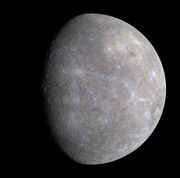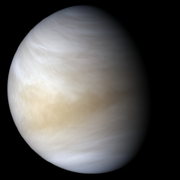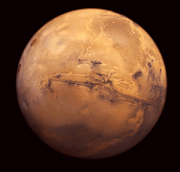The study of extraterrestrial atmospheres is an active field of research, both as an aspect of astronomy and to gain insight into Earth's atmosphere. In addition to Earth, many of the other astronomical objects in the Solar System have atmospheres. These include all the gas giants, as well as Mars and Venus. Several moons and other bodies (notably Pluto) as well as comets and the Sun. In addition, there is evidence that some extrasolar planets also have atmospheres.
Solar System planets[]
- Earth is excluded from this list as this article is about extraterrestrial atmospheres. For more information about the atmosphere of Earth, see Atmosphere of Earth.
Mercury[]

Mercury
Due to its small size, Mercury does not have a substantial atmosphere. It has an extremely thin atmosphere which mostly consists of a small amount of helium and traces of sodium, potassium, and oxygen. These gases derive from the solar wind, radioactive decay, meteor impacts, and breakdown of Mercury's crust. Mercury's atmosphere is not stable and is constantly being refreshed because of its atoms escaping into space as a result of the planet's heat.
Venus[]

Venus
Venus' atmosphere is mostly composed of carbon dioxide, with minor amounts of nitrogen and other trace elements including compounds based on hydrogen, nitrogen, sulfur, carbon, and oxygen. The atmosphere of Venus is much hotter, denser, and deeper than that of Earth.
The troposphere begins at the surface and extends up to an altitude of 65 kilometres (an altitude at which the mesosphere has already been reached on Earth). At the top of the troposphere, temperature and pressure reach Earth-like levels. Winds at the surface are typically at around 11 - 15 mph (5 - 6 m/s) while in the upper troposphere it can reach to around 167 mph (75 m/s). The stratosphere and mesosphere extend from 65 km to 95 km in height. The thermospherre and exosphere begin at around 95 kilometers, eventually reaching the limit of the atmosphere at about 220 to 250 km.
The air pressure at Venus' surface is about 92 times that of the Earth. The enormous amount of CO2 in the atmosphere creates a strong greenhouse effect, raising the surface temperature to about 878 °F (470 °C, 743 °K) which makes it the hottest planet in the Solar System.
Mars[]

Mars
Mars has a very thin atmosphere composed mainly of carbon dioxide, with some nitrogen and argon. The average surface pressure on Mars in 0.6 - 0.9 kPa, compared to 101 kPa on Earth. This results in a much lower atmospheric thermal inertia, and as a consequence Mars is subject to strong thermal tides that can change total atmospheric pressure by up to 10%. The thin atmosphere also increases the variability of the planet's temperature. Martian surface temperatures vary from lows of approximately -220°F (-140°C, 133°K) during the polar winters to highs of around 72°F (22°C, 295°K)
Between 1975 and 1995, Mars warmed by about 1.2°F (0.65°C) due to dust storms that made its surface darker so that it absorbed more sunlight. Changes in pits in the layer of frozen carbon dioxide at the Martian south pole observed between 1999 and 2001 suggest the south polar ice cap is shrinking. More recent observations indicate that Mars' south pole is continuing to melt. "It's evaporating right now at a prodigious rate," says Michael Malin, principal investigator for the Mars Orbiter Camera. The pits in the ice are growing by about 3 meters (9.8 ft) per year. Malin states that conditions on Mars are not currently conductive to the formation of new ice. NASA has suggested that this indicates a "climate change in progress" on Mars.
Jupiter[]
Jupiter's upper atmosphere is composed of about 75% hydrogen and 24% helium by mass, with the remaining 1% consisting of other elements.